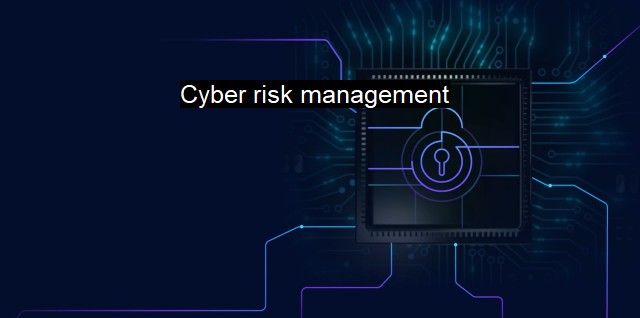What is Cyber risk management?
Understanding Cyber Risk Management in an Increasingly Technology-Dependent World: A Guide to Securing Personal and Business Data from Cyber Attacks through Cybersecurity and Antivirus Measures
Cyber risk management is a strategic approach that organizations use to handle the potential threats triggered by the usage of digital systems and online networks. In this era of rapid technological advancement, unending streams of cybersecurity threats have continually endangered businesses, necessitating proactive management and mitigation solutions. Through cyber risk management, organizations can understand, manage, and minimize risks associated with their digital operating systems, aiming to eliminate any devastating repercussions.In today’s world, a secure cyber environment is more of a necessity than a luxury. It's an undeniable fact that businesses - whether small start-ups or multinational corporations - draw significant advantages from evolving technology. the immense benefits come coupled with a host of cyber threats like data theft, malware, and ransomware attacks, loss of confidentiality, data integrity, and availability issues. Consequently, businesses have recognized the importance of employing robust cyber risk management measures to protect their digital environment and their bottom line.
Cyber risk management involves adopting a multi-layered approach. It typically includes threat identification, assessment, and prioritization of risks, further supplemented with coordinated application of resources for minimizing the impact of unfortunate cyber events. Organizations need to understand their risk tolerance and align their defensive strategies accordingly for an effective risk management plan.
Each organization's specific corporate environment, values, mission, and risk-taking ability play crucial roles in determining appropriate cyber risk measurement and mitigation strategies. These individual factors guide the strategy towards balancing the risks and rewards of cyberspace usage. Cyber risk management, therefore, is tailored based on an organization's unique circumstances and objectives. external factors such as the organization's regulatory environment and the prevalent cybersecurity trends can likewise shape your cyber risk management strategy.
One major component of cyber risk management is threat identification, where an organization pinpoints cyber risks it may face. This process requires an assessment of the organization's vulnerabilities and the probable threats that could exploit these loopholes. Post threat identification, the organization assesses and evaluates the risk based on their potential impact on the business's operational functionality and continuity.
Risk assessment typically involves estimation of the likelihood of a cyber threat followed by the evaluation of the extent to which that threat can negatively affect the organization's goals. would data theft lead to business downtimes or loss of customer trust? Can the business recover from the economic fallout? Or would any regulatory issues arise? In risk assessment, these questions are answered to determine the gravity and urgency of the threats.
Cyber risk management also entails developing strategies to mitigate the recognized risks. This stage involves laying out procedures and guidelines that minimize the probability of risk occurrence and minimize its impact if it indeed takes place. Risk mitigation strategies can range from training employees on cybersecurity protocols to regular software updates and system patching, from installing advanced security software like antivirus programs to undertaking regular system scans.
Cyber risk management also emphasizes monitoring and constant tweaking of the implemented strategies. This is crucial since cyber threats are ever-evolving, with attackers always seeking new ways to bypass security measures. Consequently, the organizations must regularly update their systems, patch vulnerabilities, develop a comprehensive incident response plan, and undertake regular system audits to identify security loops, if any.
Encouraging cybersecurity consciousness as part of organizational culture is pivotal for effective risk management. Deriving support from experienced cybersecurity professionals and creating an environment that fosters vigilance and proactive risk management is necessary to safeguard not only the organization's digital assets but also its reputation, legal standing, and financial status.
Cyber risk management is an essential strategic approach for businesses to stay ahead in this escalating war against cyber threats. Given its potential to significantly impact an organization’s bottom line, it definitely goes beyond being only an IT issue. Cyber risk management is a business-wide concern, necessitating organization-wide participation, strengthening defenses, and fostering resilience against potential cyber threats.

Cyber risk management FAQs
What is cyber risk management?
Cyber risk management is the process of identifying, assessing, and mitigating potential cybersecurity threats and vulnerabilities within an organization. It involves implementing strategies and measures to prevent or minimize the impact of cyber attacks.Why is cyber risk management important?
Cyber risk management is important because cyber threats are constantly evolving, and organizations must keep up with these threats to ensure the safety and security of their sensitive information. Cyber attacks can result in financial losses, damage to reputation, and legal liabilities.What are some common strategies used in cyber risk management?
Some common strategies used in cyber risk management include implementing strong passwords, encryption, firewalls, and antivirus software. Additionally, regular employee training, conducting regular security assessments, and having an incident response plan in place are also important strategies.Who is responsible for cyber risk management within an organization?
Cyber risk management is a collective responsibility involving all employees within an organization. However, the ultimate responsibility for cybersecurity often falls on executive management, who must ensure that the necessary measures and resources are in place to prevent a cyber attack.| | A | | | B | | | C | | | D | | | E | | | F | | | G | | | H | | | I | | | J | | | K | | | L | | | M | |
| | N | | | O | | | P | | | Q | | | R | | | S | | | T | | | U | | | V | | | W | | | X | | | Y | | | Z | |
| | 1 | | | 2 | | | 3 | | | 4 | | | 7 | | | 8 | | |||||||